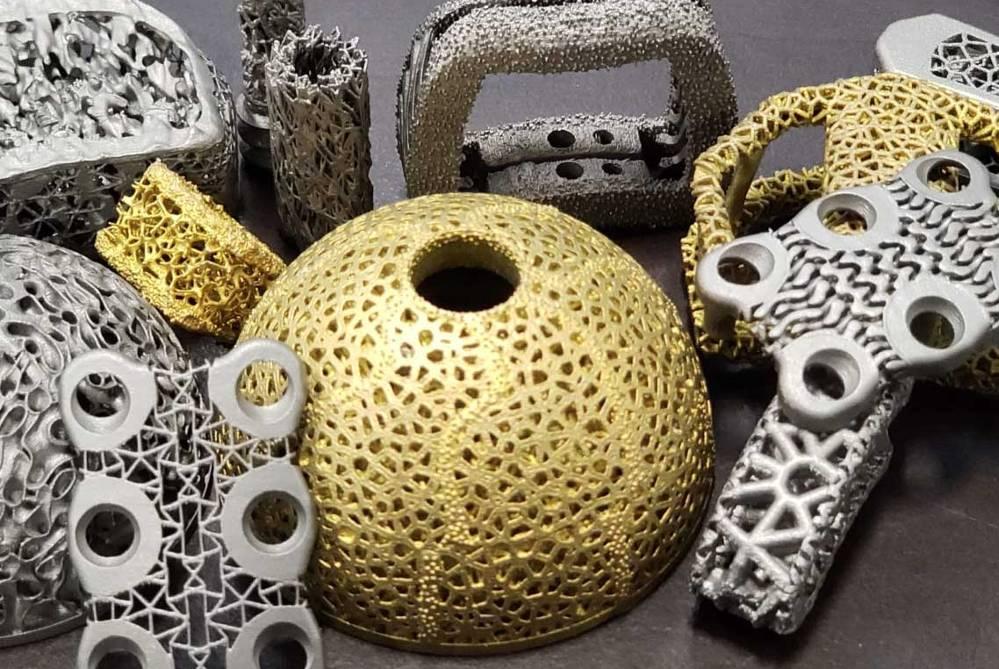- FMA
- The Fabricator
- FABTECH
- Canadian Metalworking
Our Publications
Categories
- Additive Manufacturing
- Aluminum Welding
- Arc Welding
- Assembly and Joining
- Automation and Robotics
- Bending and Forming
- Consumables
- Cutting and Weld Prep
- Electric Vehicles
- En Español
- Finishing
- Hydroforming
- Laser Cutting
- Laser Welding
- Machining
- Manufacturing Software
- Materials Handling
- Metals/Materials
- Oxyfuel Cutting
- Plasma Cutting
- Power Tools
- Punching and Other Holemaking
- Roll Forming
- Safety
- Sawing
- Shearing
- Shop Management
- Testing and Measuring
- Tube and Pipe Fabrication
- Tube and Pipe Production
- Waterjet Cutting
Industry Directory
Webcasts
Podcasts
FAB 40
Advertise
Subscribe
Account Login
Search
Ohio additive manufacturing company puts down roots in implant market
Nine-year-old Tangible Solutions 3D-prints thousands of orthopedic implants monthly
- By Kip Hanson
- Updated June 6, 2022
- June 3, 2022
- Article
- Additive Manufacturing

Tangible Solutions additively manufacturers thousands of orthopedic components monthly. Images: Tangible Solutions
Some business plans take time to mature. So it was with Tangible Solutions Inc. of Fairborn, Ohio.
Co-founders Adam Clark and Chris Collins began 3D-printing plastic parts in Collins’ garage in 2013, then carried the parts door to door to show prospective clients their manufacturing capabilities. Those days are gone.
Today, Tangible Solutions is a serious player in the highly competitive and regulated orthopedic implant industry, producing thousands of the devices monthly.
“During those early days, our vision came into focus,” said Clark. “We ended up meeting a lot of medical folks and soon discovered an opportunity for additive manufacturing. So we ran the numbers, got some financing, set up a corporation, and moved into a new building.”
Today, the company prints roughly 50,000 titanium implants a year in its 25,000-sq.-ft. facility.
From 3 to 3 Dozen
There’s much more to the Tangible story. What once was a three-member staff—Collins, Clark, and a helper—now numbers nearly three dozen. And the pair of FDM (fused deposition modeling) printers the company started with are long gone, replaced by three Concept Laser M2 machines from GE Additive, with two more on the way. There are also eight of GE’s smaller Mlab 3D metal printers, with another two on order, as well as a Mitsubishi Wire EDM and a handful of Hurco machining centers, several with five-axis capabilities.
And because Tangible is vertically oriented, it also has laser marking and other postprocessing capabilities, including passivation and proprietary finishing processes. Practically all of it runs around the clock.
“Business really took off,” said Clark. “We’ve been very fortunate, not only with our rapid growth but the great team we’ve assembled.”
The company is ISO 13485:2016-certified and registered with the FDA, and its website proclaims it as a “Leading Contract Manufacturer Of American-Made 3D Printed Titanium Orthopedic Implants.” So whether making plates and screws for spinal fusion or tibial trays and acetabular cups, company efforts are totally focused on additively manufacturing implants.
Staying the Course
Given the Ohio company’s experience with metal 3D printing and extensive capabilities, some ask why not expand into other markets?
“Very few in the additive industry can actually produce implants, so we have a small but effective hold on our particular market corner,” Clark said. “And once we’d set our mind on doing it, we were committed to pursuing this dream. It’s a special feeling building a company that will hopefully outlive us. I’m never going to quit.”
Part of the company’s success in the niche results from its powder program. Clark often receives drawings that specify “must use virgin material.” Tangible rarely does, however, routinely re-using powder—in some cases up to 40 times. Learning how to do this wasn’t easy, though. The company invested significant sums of money to streamline the recycling process and ensure that all powder, virgin or otherwise, meets the required quality standards.
“When I tell prospects that we’re happy to use fresh powder with each job but they will then pay 10 times as much for the finished part, they quickly change their mind,” said Clark.
One market that Tangible likely will pursue is foot and ankle implants, followed by larger parts such as hip joints. Each represents unique design and build challenges quite different than those that Clark and Collins faced when first delving into spinal products, which currently accounts for the majority of their business.
“Just as it was when 3D printing began to get a foothold, it will take time before the industry is willing to adopt new manufacturing methods,” said Clark. “I think we have a runway of maybe five years before those segments begin to take off.”
There are pros and cons to focusing on a single market, he noted. On the positive side, the company now has met the medical industry’s stringent regulatory requirements. It has developed the requisite processes, filled out the paperwork, and achieved the necessary certifications. The downside, of course, is that it took six years of fairly grueling work to do so.
Clark wouldn’t have it any other way, though. “That was our goal, and we knew going in that it would be challenging. In some ways, it was more difficult than we anticipated, but we’ve accomplished what we set out to do. What more can anyone ask?”
About the Author

Kip Hanson
About the Publication
- Podcasting
- Podcast:
- The Fabricator Podcast
- Published:
- 04/16/2024
- Running Time:
- 63:29
In this episode of The Fabricator Podcast, Caleb Chamberlain, co-founder and CEO of OSH Cut, discusses his company’s...
- Trending Articles
- Industry Events
16th Annual Safety Conference
- April 30 - May 1, 2024
- Elgin,
Pipe and Tube Conference
- May 21 - 22, 2024
- Omaha, NE
World-Class Roll Forming Workshop
- June 5 - 6, 2024
- Louisville, KY
Advanced Laser Application Workshop
- June 25 - 27, 2024
- Novi, MI




























